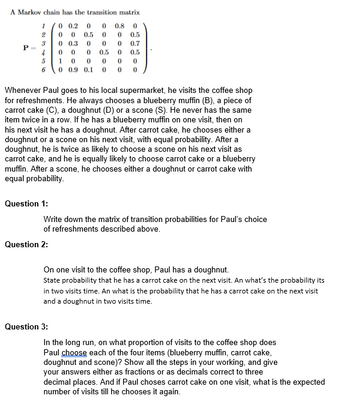
MATLAB: An Introduction with Applications
6th Edition
ISBN: 9781119256830
Author: Amos Gilat
Publisher: John Wiley & Sons Inc
expand_more
expand_more
format_list_bulleted
Question
Please see attached

Transcribed Image Text:A Markov chain has the transition matrix
1
0 0.2 00 0.8 0
2
0 0
0.5 0
0 0.5
3
0 0.3
0 0
0.7
4
0 0
0
0.5
0.5
1 0
0
0
0
0
0 0.9 0.1 0 0
0
P =
5
6
Question 1:
Whenever Paul goes to his local supermarket, he visits the coffee shop
for refreshments. He always chooses a blueberry muffin (B), a piece of
carrot cake (C), a doughnut (D) or a scone (S). He never has the same
item twice in a row. If he has a blueberry muffin on one visit, then on
his next visit he has a doughnut. After carrot cake, he chooses either a
doughnut or a scone on his next visit, with equal probability. After a
doughnut, he is twice as likely to choose a scone on his next visit as
carrot cake, and he is equally likely to choose carrot cake or a blueberry
muffin. After a scone, he chooses either a doughnut or carrot cake with
equal probability.
0
Question 2:
0
Write down the matrix of transition probabilities for Paul's choice
of refreshments described above.
Question 3:
On one visit to the coffee shop, Paul has a doughnut.
State probability that he has a carrot cake on the next visit. An what's the probability its
in two visits time. An what is the probability that he has a carrot cake on the next visit
and a doughnut in two visits time.
In the long run, on what proportion of visits to the coffee shop does
Paul choose each of the four items (blueberry muffin, carrot cake,
doughnut and scone)? Show all the steps in your working, and give
your answers either as fractions or as decimals correct to three
decimal places. And if Paul choses carrot cake on one visit, what is the expected
number of visits till he chooses it again.
Expert Solution
This question has been solved!
Explore an expertly crafted, step-by-step solution for a thorough understanding of key concepts.
Step by stepSolved in 4 steps

Knowledge Booster
Similar questions
Recommended textbooks for you
 MATLAB: An Introduction with ApplicationsStatisticsISBN:9781119256830Author:Amos GilatPublisher:John Wiley & Sons Inc
MATLAB: An Introduction with ApplicationsStatisticsISBN:9781119256830Author:Amos GilatPublisher:John Wiley & Sons Inc Probability and Statistics for Engineering and th...StatisticsISBN:9781305251809Author:Jay L. DevorePublisher:Cengage Learning
Probability and Statistics for Engineering and th...StatisticsISBN:9781305251809Author:Jay L. DevorePublisher:Cengage Learning Statistics for The Behavioral Sciences (MindTap C...StatisticsISBN:9781305504912Author:Frederick J Gravetter, Larry B. WallnauPublisher:Cengage Learning
Statistics for The Behavioral Sciences (MindTap C...StatisticsISBN:9781305504912Author:Frederick J Gravetter, Larry B. WallnauPublisher:Cengage Learning Elementary Statistics: Picturing the World (7th E...StatisticsISBN:9780134683416Author:Ron Larson, Betsy FarberPublisher:PEARSON
Elementary Statistics: Picturing the World (7th E...StatisticsISBN:9780134683416Author:Ron Larson, Betsy FarberPublisher:PEARSON The Basic Practice of StatisticsStatisticsISBN:9781319042578Author:David S. Moore, William I. Notz, Michael A. FlignerPublisher:W. H. Freeman
The Basic Practice of StatisticsStatisticsISBN:9781319042578Author:David S. Moore, William I. Notz, Michael A. FlignerPublisher:W. H. Freeman Introduction to the Practice of StatisticsStatisticsISBN:9781319013387Author:David S. Moore, George P. McCabe, Bruce A. CraigPublisher:W. H. Freeman
Introduction to the Practice of StatisticsStatisticsISBN:9781319013387Author:David S. Moore, George P. McCabe, Bruce A. CraigPublisher:W. H. Freeman

MATLAB: An Introduction with Applications
Statistics
ISBN:9781119256830
Author:Amos Gilat
Publisher:John Wiley & Sons Inc

Probability and Statistics for Engineering and th...
Statistics
ISBN:9781305251809
Author:Jay L. Devore
Publisher:Cengage Learning

Statistics for The Behavioral Sciences (MindTap C...
Statistics
ISBN:9781305504912
Author:Frederick J Gravetter, Larry B. Wallnau
Publisher:Cengage Learning

Elementary Statistics: Picturing the World (7th E...
Statistics
ISBN:9780134683416
Author:Ron Larson, Betsy Farber
Publisher:PEARSON

The Basic Practice of Statistics
Statistics
ISBN:9781319042578
Author:David S. Moore, William I. Notz, Michael A. Fligner
Publisher:W. H. Freeman

Introduction to the Practice of Statistics
Statistics
ISBN:9781319013387
Author:David S. Moore, George P. McCabe, Bruce A. Craig
Publisher:W. H. Freeman